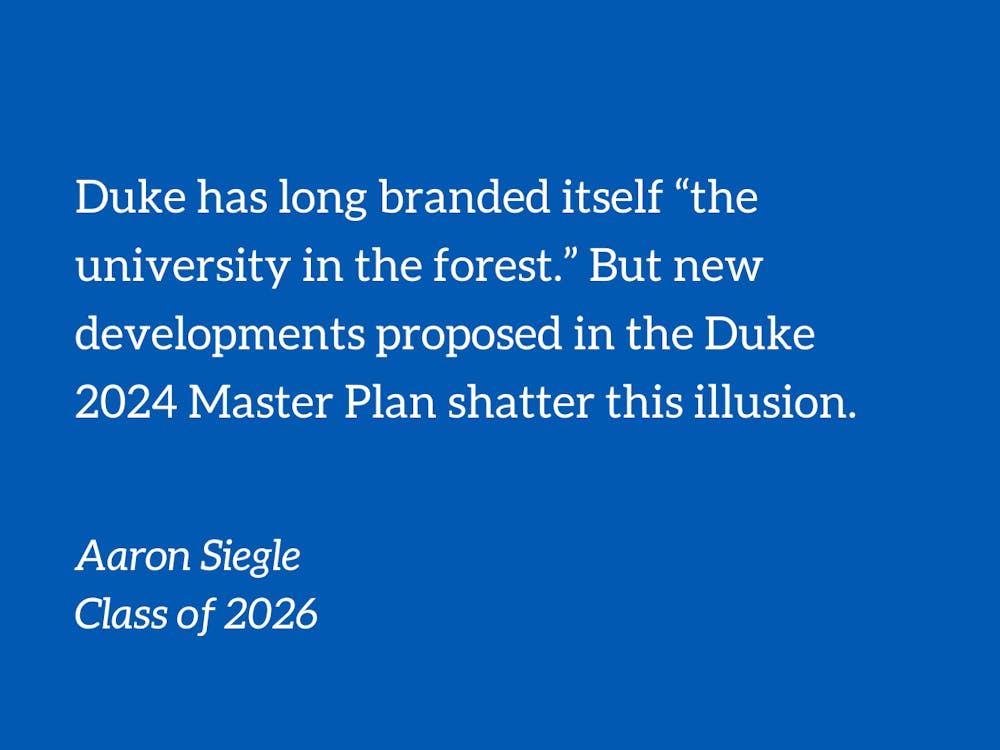Duke has long branded itself “the university in the forest.” But new developments proposed in the Duke 2024 Master Plan shatter this illusion. Graduate housing behind the Fuqua School of Business, an additional quad behind Edens, and a major expansion of the Duke Medical Center are just a few of the projects outlined in the plan. Collectively, these new additions would result in a loss of 11 acres of tree cover on campus, degrading both ecological and human health. The unchecked growth of the campus’ physical footprint contradicts with the Duke Climate Commitment, where university leaders pledged to “imagine, design and implement a sustainable future for all.” If Duke truly wants to be a leader in addressing climate change, then the university must align its actions with its words.
When West Campus was designed in the 1920s, the planners, Horace Trumbauer, Julian Abele, and the Olmstead brothers, were intentional about designing a university that incorporated natural features. Their legacy of environmental protection is reflected in conservation zones (Fuqua Forest, Al Buehler Trail, Sandy Creek riparian area) around campus, where “development is highly discouraged.” However, the 2024 plan disregards these guidelines, recommending the construction of dorms and expanding the medical center in the conservation zones.
These developments undercut the principles outlined in the Master Plan itself. Principle three states that “Duke is a university in the forest.” But Duke can’t be a university in the forest if its trees are felled for new buildings! The proposed developments alone would absorb over 5 percent of total tree cover on campus, many in vital areas that students use. Yes, there are still plenty of trees in the Duke Forest, but this valuable green space is still more accessible to students with cars than those without.
Previous battles were fought in 2014 to protect the Chapel Woods and Anderson Woods (behind the Wellness Center), highlighting how mobilization has been successful in preserving green space on campus. Having forest interspersed among the academic buildings of the campus has aesthetic value, reminding students of their connection to nature every time they walk to class. It also well known that greenspace contributes to academic focus and emotional well-being.
With principle five declaring that “Duke is a leader in environmental stewardship,” it’s clear that the administration is concerned about its reputation as an environmental trailblazer. Promotional materials highlighting Duke’s sustainable steps blanket the campus. As part of its Climate Commitment, Duke has pledged to be carbon neutral by 2024. But delving into the specifics of these programs, one sees a pattern of ‘offshoring’ sustainable behavior. The carbon neutrality target relies heavily on offsite carbon offsets. And the Duke Climate Commitment focuses on education, external engagement, and community partnership. While these initiatives are valuable, they conveniently sidestep addressing the sprawling, car-centric campus that Duke has become.
Duke devotes a whopping 102 acres of campus to parking lots, disrupting water percolation into the soil and exacerbating the water shortage that spurred the development of the Duke Pond in 2015. Besides being a poor use of land, parking incentivizes driving to campus instead of considering more climate friendly alternatives. It’s paradoxical that principle six of the Master Plan reads “Duke is a pedestrian campus.” Since new developments in the plan are on the edges of campus, students will have to cross multiple major roads to get to class. A more pedestrian friendly alternative would be to support a public transit system like the Durham-Chapel Hill Light Rail project, which the administration blocked in 2018.
Some may argue that the new constructions are necessary to alleviate the housing shortage on campus. But in reality, additional housing will unleash a vicious cycle of enrollment growth, larger incoming classes, and more pressure to add structures in a finite space. Duke’s moderate size and close-knit community are what make it a special place to live and learn.
Duke can’t and doesn’t need to rely on a growth model of constant expansion to fuel its success. There will eventually be no more forests to cut down and no more green space to fill in. To protect the environmental character of Duke, and thus the Duke experience, two steps need to be taken. First, capping undergraduate and graduate enrollment will mitigate stress on the campus infrastructure and maintain Duke’s liberal arts college ethos. Second, the school must establish conservation easements on tracts of forest around campus, legally protecting the land from development in perpetuity, preventing future administrations from indulging in the temptations of expansion.
Over the years, Duke has outpaced other universities in protecting nature on campus. Yet, it needs to be reminded of the principles it strives to attain. Duke can still grow as a university without expanding its physical footprint. In the process, it can provide a blueprint for other institutions to do the same.
Aaron Siegle is a Trinity first-year.
Editor’s Note: Post-publication, it was brought to The Chronicle’s attention that Duke has a Lyft Rides Program, which covers up to a set dollar amount of transportation costs for certain Lyft rides that Duke students and employees can take to the Duke Forest Shepherd Nature Trail, among other designated locations.
Get The Chronicle straight to your inbox
Signup for our weekly newsletter. Cancel at any time.

